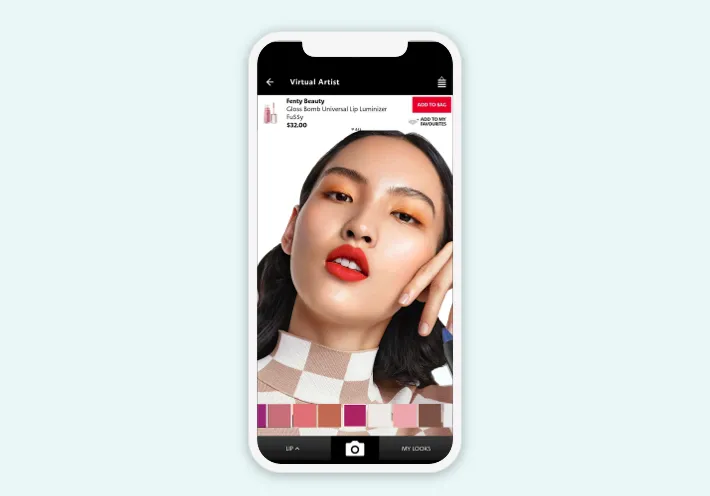Online shopping, while extremely convenient, comes with one drawback: you cannot touch and try on products. Augmented reality in eCommerce that bridges virtual and physical worlds offers a viable solution to this challenge.
While AR may not fully recreate brick-and-mortar stores, it provides customers with more details about your products. Picture them visualizing furniture in their living spaces or trying on eyeglasses with an AR mask. Given this transformative impact, it’s unsurprising that nearly one-third of US consumers will have used this tech for online purchases by 2025.
Read on to learn more about AR for eCommerce, with its benefits, features, and use cases explained. Explore the potential challenges and considerations before adopting this technology. Leverage GenovaWebArt’s practical insights, backed up by over ten years of eCommerce experience, to push your online store forward.

Benefits of AR in eCommerce
Using augmented reality for eCommerce is beneficial for both retailers and customers. Here are just several compelling advantages of this tech:
Enhanced Product Visualization
Go beyond regular images and videos and display your products most effectively with augmented reality. This benefit extends to:
- 3D models that show your products from every angle, giving your customers a glimpse into the item’s size and shape.
- Virtual try-ons that allow your customers to “wear” clothes and accessories virtually.
Improved Decision-Making
With eCommerce augmented reality, customers get more information about your product and become confident about their purchases. Some notable advantages include:
- Detailed product specifications and user reviews integrated into your store shape your customer’s purchasing decisions.
- AR allows customers to compare your products and helps them select the most suitable option.
Engaging and Interactive Shopping Experience
AR shopping is inherently interactive. Thus, customers engage more when scrolling through your offerings. For the maximum benefit, you can also enable the following:
- Gamification elements that make customers enjoy the shopping process more.
- Virtual tours or interactive product demonstrations allow consumers to experience your items almost firsthand.
AR vs. VR in eCommerce: Which Is More Effective?
Even though AR and VR often go hand in hand, these are distinct technologies. Let’s get each of them straight.
- Augmented reality superimposes digital information onto physical objects and environments.
- Virtual reality creates an entirely immersive, computer-generated environment.
AR proves to be more effective for eCommerce, and here’s why:
- AR is more accessible, requiring only a smart device with a camera. VR, on the other hand, necessitates specific, often expensive headsets.
- AR is generally more cost-effective to implement for both retailers and customers.
- AR smoothly integrates into the user’s environment and offers additional insights for online shopping. VR, while immersive, creates a more isolated experience.
While these are both powerful technologies, they serve distinct use cases. Augmented reality is perfect for online retail, especially in virtual try-ons or product visualizations. Virtual reality is best for specialized applications like gaming or training simulations.
AR Features in eCommerce
You can upgrade your store with several features by using augmented reality. Let’s look at each of them in greater detail:
- Virtual try-ons. This feature lets your customers try on clothes, accessories, and even makeup virtually. It visualizes how products look on them before a purchase.
- Room planning. AR in e-commerce allows customers to preview furniture and home decor items straight in their houses. Shoppers can check how products will fit by using their smartphones with cameras and placing virtual objects within their rooms.
- Product interaction. AR transforms how customers view and interact with your products. With this feature, they can zoom in and out, rotate, and examine items up close.
- Social media filters. This feature works as both a marketing and sales tool. Customers can use filters to try your products, simultaneously promoting them on social media.
- Interactive user manuals. This feature improves the post-purchase experience and will suit your business if you sell products with a steep learning curve. Customers can use AR to access detailed instructions on how your product works.
How to Bring AR to Your eCommerce Business
If you’re willing to implement augmented reality in eCommerce, here are several steps to take:
- Determine your business objectives. Define what you want to achieve from AR implementation and set measurable goals. Identify areas where the new tech can improve customer experience and increase conversion rates.
- Decide on the AR tools you’ll use. Explore the augmented reality tools available and check if they coincide with your business goals. Consider the operating systems necessary, features, supported devices, and costs.
- Create a demo. Develop a demo to see how the AR tool impacts your eCommerce store.
- Test the AR tool. Check the AR features before introducing them to your customers. Fix all bugs and glitches to ensure an excellent user experience.
- Make your AR functionality live. Display the new augmented reality features to your customers. Provide user guidance and tooltips for hassle-free shopping.
On top of that, handle regular eCommerce website maintenance after introducing AR features. This way, you’ll make sure your store works properly.
Challenges and Considerations of Implementing AR in eCommerce
Leveraging augmented reality for online shopping is a promising venture, yet it comes with certain challenges and considerations. Let’s explore them in greater detail:
Technical Challenges
Delivering a top-notch AR shopping experience means tackling various technical limitations. Those may include compatibility issues, system integration complexities, and the need for AR proficiency in general.
User Accessibility
When introducing augmented reality eCommerce, it’s necessary to ensure that these features are user-friendly and accessible to a broad audience. Pay attention to device compatibility, user interface design, and the learning curve for using AR functionalities.
Privacy and Data Security
When implementing AR in your store, you deal with customer data collection and processing. Owing to that, you should ensure robust data protection measures, including transparent data usage policies, secure data storage, and encryption.
Case Studies of Using Augmented Reality in eCommerce
Now that you know all the details about AR in eCommerce, let’s look at real-world examples.
IKEA Place
IKEA, a home design brand, launched a mobile app that lets users virtually place furniture in their homes using AR. This application features true-to-scale visualization, contributing to an immersive experience and informed shopping decisions.

Sephora Virtual Artist
Sephora, a well-known beauty product retailer, offers a mobile app featuring virtual try-ons. Customers can experiment with various makeup products in real time to figure out the perfect shades and styles that complement their unique features.

These are just two augmented reality eCommerce examples. But there are more.
If you’re interested in exploring other eCommerce projects or discovering eCommerce website development cost, feel free to scroll through our website.



![Shopify Sales Channels [Complete Guide] - GenovaWebArt blog article, banner image Shopify Sales Channels [Complete Guide] - GenovaWebArt blog article, banner image](https://genovawebart.com/hubfs/img/webp/hero-banner-blog-article-shopify-sales-channels.webp)



